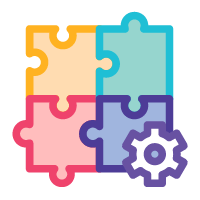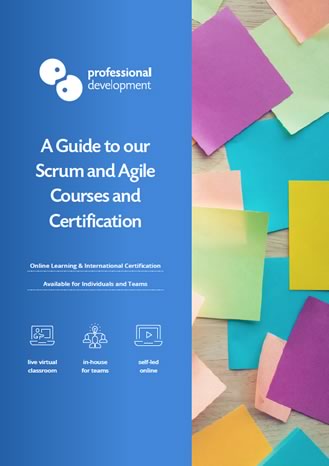What is the Scrum Team?
Originally Published, 2019. Updated March 2022.If you work in project management or are interested in moving into a project-related role, it’s likely that you have heard about Scrum.
Over the past 20 years, Scrum has become an extremely popular approach for managing projects in an adaptive, team-centred environment.
Today, a Scrum qualification is an attractive addition to any project manager’s portfolio.
To know where you should begin your training and certification, it is important to understand how a Scrum team works and become familiar with its various roles.

In this article, we look at why the team is so important, the roles and who they are suited to, and how the team works.
Guidance on Choosing a Scrum Certification
Download our Guide to Scrum and Agile Courses and Certification for insights into the right course and qualification for your needs.
This 16-page guide includes a concise overview of each qualification available.
Download GuideCovered In This Article:
You can use the index below to jump to any section.
Why is the Scrum Team so Important?
The success of any Scrum project hangs on the Scrum team. They are the key to making each element of the initiative work.
The Scrum approach to managing projects was inspired by the self-organising nature of rugby teams. This means that Scrum thrives on a tightly-knit team working well together.
A well-trained, confident team can yield so many important benefits for a project, such as:
- Clear, efficient communication
- Lower risk
- Improved profitability
- Creative solutions to obstacles and project roadblocks

What are the 5 Scrum Values?
Each member must understand their role and follow the 5 Scrum Values to ensure that everything flows smoothly.
Respect:
Members must respect each other.
Focus:
The team focuses on the work to achieve the goals of the Sprint.
Openness:
Clear and open communication throughout the Sprint, between the team members and other stakeholders.
Commitment:
Each person within the team commits to the goals of the Sprint.
Courage:
Individual members have the courage to face up to tricky problems and to do what is right in any given situation.
What are the roles of a Scrum team?
The roles and responsibilities are very clearly outlined so that everyone knows what is expected from their work.

Scrum Product Owner
You will often hear this role referred to as “the key stakeholder”. This is because a Scrum Product Owner communicates with and advocates for the customer throughout a Sprint.
They define the Sprint criteria and will work with the Scrum Master to reframe priorities as the Sprint progresses.
Product Owners stay focused on the end result at all times. They are “big picture” thinkers, helping the rest of the team and the customer move towards the goals.
Sounds Like You?
If you think this role is the right path for your career, take a look at our Scrum Product Owner programme.
This online, self-led course will equip you with a strong foundational understanding of Scrum and how to perform the Product Owner role.
It also leads to an internationally recognised Scrum Product Owner Certified (SPOCTM) qualification (included in your course fee).
Get Course Brochure View Course

Scrum Master
The role of Scrum Master is the most popular of all Scrum team roles. It’s so much in demand, that we run a public course all year round.
Why is it so popular? Perhaps it's because the Scrum Master is the main facilitator for implementing Scrum successfully. They create the ideal working environment and protect the team from disruptive interruptions throughout the Sprint.
They also work closely with the Product Owner to continuously evaluate and reframe priorities throughout the cycle.
Sounds Like You?
If you think this is the place to begin, our Scrum Master course could be the perfect fit.
As with our Product Owner training, a globally recognised certification, Scrum Master Certified (SMCTM) is included.

Scrum Developers (the Scrum Team)
Scrum Developers are often simply called the “scrum team members”. They work on the project to create its deliverables.
They also communicate regularly with the Scrum Master and Product Owner.
Developers must have a good understanding of how Scrum works so that they can actively contribute to the Sprint.
Sounds Like You?
Our self-led, e-learning course for this role is ideal for anyone who wants to learn how to be a contributing member of a team.
It includes everything you need to become familiar with best practices and to prepare for your Scrum Developer Certified (SDCTM) exam (included in your course price).
Get Course Brochure View Course
Stakeholder: The Unofficial Role
There is a 4th, unofficial role within the team: the stakeholder.
They do not create any of the project’s deliverables, but as mentioned in Indeed’s article on Scrum Teams, stakeholders in a Scrum project have a high level of input and influence on the project’s outcome.
How does the Team Work?
Scrum projects run in short cycles called “Sprints”. These cycles are typically between two and 4 weeks in duration.
With such a focused timeframe, there is a lot going on in every Sprint. Keeping track of everything requires the team to work in harmony, adhering to Scrum Values.
Here is a simplified look at how they do it:
Communicate and Collaborate Regularly
The Daily Stand-Up is a well-known part of the Scrum architecture.
Every morning, the team have a short meeting (usually 15 minutes). Everyone discusses what they did yesterday, what they plan to do today, and any obstacles in their way.
This is a super platform for creating visibility, avoiding confusion, and sharing both ideas and solutions.

Understand Scrum
Everyone on the Scrum team must be familiar with and understand the fundamentals of Scrum.
This ensures everyone is using common terminology and a shared approach to work.

Stay Within Their Role…
Roles on a Scrum Team are so definitely outlined for a very good reason.
Each member must focus on ensuring the responsibilities within their role are covered.

Trust The Team
It follows that you need to trust your fellow team members to do the same.
A large part of what makes Scrum teams work is that everyone trusts that everyone else has their responsibilities under control, or will communicate clearly if an obstacle to completing their tasks arises.

Where do you fit within the Scrum Team?
This is an interesting question. Many project managers are choosing to train in more than one role, so that they can slot into whichever they suit best in a particular Sprint.
The most popular place to begin your journey is by learning about and getting certified in the Scrum Master role.
However, if you would like some guidance on what works best for your situation, get in touch.
Our consultants have plenty of experience with these qualifications and are certified Scrum Masters themselves.
You can reach us by phone (Freephone 1800 910 810), request a call back, or ask a question online below.
In-Company Training: Tailored Scrum for Your Team
If you would like to organise training for your team, we can create a tailored solution to fit your precise needs.
Our in-company Scrum training is extremely flexible – perfect for organisations that need a mix of Scrum Product Owners, Scrum Masters and Scrum Developers.
Further Reading and Resources
If you would like to get started by learning more about Scrum project management, why not take a few minutes to read some of our most popular articles?



